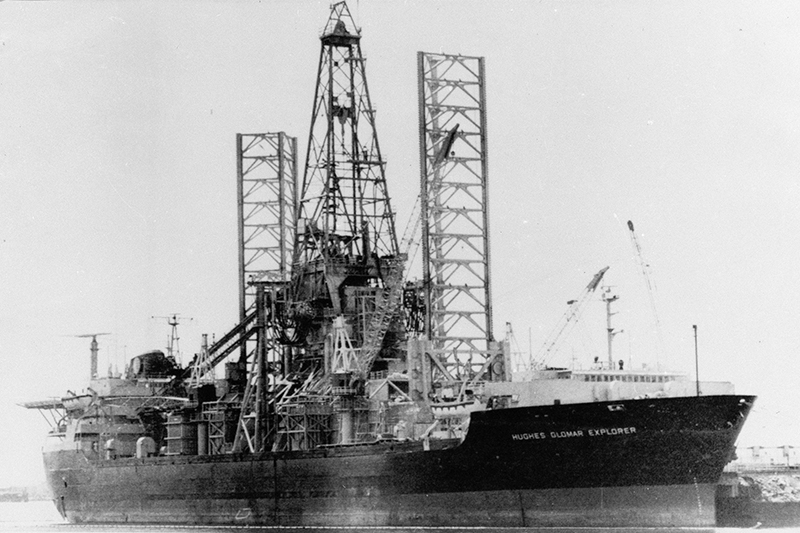When The CIA’s Sub Heist Ship Visited Bermuda
It was one of the most extraordinary, and extraordinary looking, ships to ever call in Bermuda.
The Glomar Explorer couldn’t help but turn heads and set tongues wagging when it dropped anchor just off the island in August, 1973.
The recently launched 63,000 ton, 620-foot ship’s most attention-grabbing feature was the sky-spearing lattice tower amidships, a fixture bookended by two smaller but still sizeable gantries.
While the lofty steel framework looked much like an oil derrick, the Glomar Explorer was not a drill ship.
Built between 1971 and 1972 under conditions of extreme secrecy at a Pennsylvania shipyard by industrialist Howard Hughes, the massive vessel was the flagship of a new generation of deep-sea mining vessels planned by the reclusive billionaire.
The central tower in fact housed a gigantic steel claw and its hydraulic heavy-lift operating system.
Attached to enough segments of deep-sea pipe, the claw-like grapple was capable of scooping manganese nodules and other precious mineral deposits off the seabed at depths of up to three miles.
The mysterious Glomar Explorer at the time it was conducting deep-water tests off Bermuda and anchored at the island in 1973 [from the declassified CIA archive]
The two smaller lattice structures were so-called “docking legs” which could be lowered through the Glomar Explorer’s hull to stabilise the grapple and its loads as they were being drawn back up into the ship’s interior
In fact the Glomar Explorer had been conducting its first deep-water operational tests of the revolutionary system 80 miles off Bermuda before anchoring off the island to take on a new crew and additional supplies.
After leaving Bermuda the Glomar Explorer was bound for the Pacific by way of the Strait of Magellan at the tip of South America: at more than 100 feet in width, the ship was too large to make the passage by way of the Panama Canal.
Representatives of the Hughes-owned Global Marine Development Corporation arrived on the island to greet the ship, which had become a major talking point on the island.
They provided a detailed briefing to curious local journalists and handed out press packages containing background information on the $350 million ship’s construction, limited technical specifications and some carefully cropped photographs.
But, no, there were to be no press tours of the seagoing mechanical marvel because of fears the stories that would result might inadvertently provide opportunities for industrial espionage.
All of the equipment had been purpose-built and was one-of-a-kind the Global Marine executives kindly explained; they just couldn’t risk tipping their hand to the competition.
In fact it was another kind of espionage which had the ship’s owners concerned — its real owners, that is.
Artist’s impression of the claw-like grapple being lowered through the hull of the Glomar Explorer. Image courtesy of the Central Intelligence Agency.
Many of the truncated details about Glomar Explorer’s unprecedented capabilities released in Bermuda were accurate. But the claim the ship had been designed for deep-sea mining projects was pure moonshine.
It was a classic espionage service cover story, one news reports about the ship emanating out of Bermuda helped to disseminate and cement in the public consciousness.
The Glomar Explorer had in fact been built for another purpose entirely — a clandestine Central Intelligence Agency mission to retrieve a sunken Soviet submarine.
Aviation pioneer Howard Hughes, after helping to dream up the manganese nodules fairytale, had loaned his name along with some of his engineers to the spy agency to provide a front for construction of the Glomar Explorer.
In what would be the deepest-ever salvage operation mounted up to that time, the Glomar Explorer’s claw was meant to fish a 375-foot Soviet Golf II Class strategic ballistic missile, the K-129, from the Pacific seafloor where it had sunk following a catastrophic 1968 accident..
Successfully retrieving the submarine and its missiles would give the US unprecedented insight into the state of both Soviet nuclear propulsion and weapons technology at the height of the Cold War.
Being able to study the K-129′s hull would also allow for fine-tuning of US Navy Anti-Submarine Warfare [ASW] strategy and tactics.
In the summer of 1974 the outlandish undertaking the CIA had codenamed Project Azorian got underway in the Pacific.
To find out the results see this recent Smithsonian Magazine report on a new exhibit at Washington DC’s International Spy Museum commemorating a covert operation that seems to owe more to a James Bond movie than real life, one Bermuda played a supporting role in.



